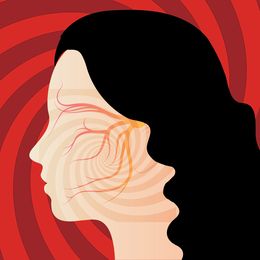Doctor, it is like a tiny gremlin tap dancing on my face!” exclaimed Mrs Sharma, a vivacious woman in her late 40s, who, despite her current predicament, still managed to accessorise her pain with a rather stylish scarf. “And not just any tap dancing,” she continued, her voice rising in pitch, “but the kind with those steel-tipped shoes! The ones that make you want to hide under the table!”
Now, facial gremlins are not typically part of a middle-aged lady’s daily routine, unless they’ve been indulging in some particularly potent homemade chutney. Mrs Sharma, however, assured me that her culinary adventures were strictly limited to the occasional over-spiced curry. A thorough examination revealed the true culprit: the trigeminal nerve, that mighty cranial nerve responsible for facial sensation and chewing, was misfiring like a faulty electrical circuit.
“So, it’s not a gremlin?” Mrs Sharma asked, her eyes wide with a mixture of disappointment and relief. “Afraid not,” I chuckled, “though I must admit, that’s one of the more creative diagnoses I’ve heard.” I explained to her the intricacies of trigeminal neuralgia and how this ‘suicide disease’, as it was grimly nicknamed, could cause excruciating pain with the slightest touch, a gentle breeze, or even a misplaced smile.
Mrs Sharma, bless her resilient spirit, was not one to be defeated by a rogue nerve. She tried medications, injections, even acupuncture (which, she reported, made her feel like a “human pincushion”). But the pain persisted, a relentless tormentor that robbed her of joy, of sleep, of the simple pleasure of enjoying a good meal without feeling like her face was being electrocuted.
“Enough is enough,” she declared one day, marching into my clinic with the determination of a warrior queen. “I want that gremlin evicted, and I want it evicted now!”
And so, we embarked on the delicate and daring mission of microvascular decompression. Imagine, if you will, a microscopic stage where a skilled surgeon, armed with tiny instruments that could make a watchmaker weep with envy, performs a delicate ballet around the trigeminal nerve. The offending blood vessel, the villain of our story, is carefully teased away from the nerve, its pulsating tyranny silenced by a tiny Teflon cushion. It’s a procedure that requires the steady hand of a master craftsman, the nerves of a bomb disposal expert, and the patience of a saint who’s been stuck in traffic for three hours.
The operation was a success. The gremlin, evicted from its prime real estate on Mrs Sharma’s face, was banished to the netherworld of neurological nuisances. And Mrs Sharma? Oh, she was ecstatic!
“Doctor,” she exclaimed at her follow-up appointment, her eyes sparkling with unadulterated joy, “I can finally smile without fear! I can eat a samosa without feeling like I’m being attacked by a swarm of angry bees! I can even… gasp… sleep on my right side!”
Her recovery was nothing short of miraculous. She returned to her life with a vengeance, embracing every moment with a newfound zest. She joined a laughter club (“It’s the best therapy!” she declared), took up salsa dancing (“It’s good for the soul and the hips!”), and even started experimenting with spicy chutneys again (“This time,” she winked, “I’ll be the one tap-dancing!”). As for the gremlin? Well, let’s just say it learned its lesson and found a new hobby, far, far away from Mrs Sharma’s radiant smile.
The author is consultant neurosurgeon at Wockhardt Hospital, Mumbai.
mazdaturel@gmail.com Instagram@mazdaturel


